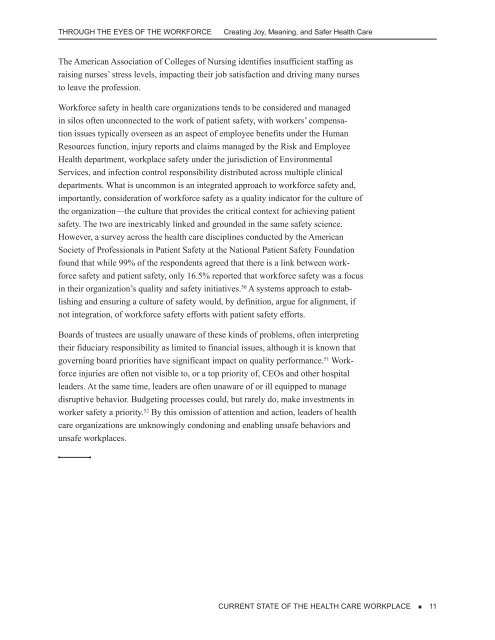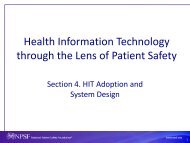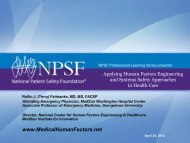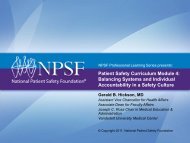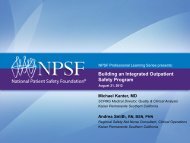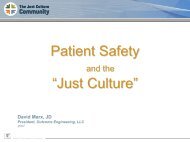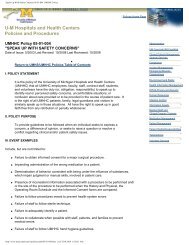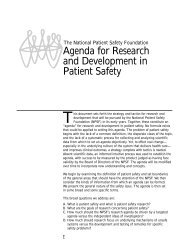Through The eyes of The Workforce - National Patient Safety ...
Through The eyes of The Workforce - National Patient Safety ...
Through The eyes of The Workforce - National Patient Safety ...
Create successful ePaper yourself
Turn your PDF publications into a flip-book with our unique Google optimized e-Paper software.
THROUGH THE EYES OF THE WORKFORCECreating Joy, Meaning, and Safer Health Care<strong>The</strong> American Association <strong>of</strong> Colleges <strong>of</strong> Nursing identifies insufficient staffing asraising nurses’ stress levels, impacting their job satisfaction and driving many nursesto leave the pr<strong>of</strong>ession.<strong>Workforce</strong> safety in health care organizations tends to be considered and managedin silos <strong>of</strong>ten unconnected to the work <strong>of</strong> patient safety, with workers’ compensationissues typically overseen as an aspect <strong>of</strong> employee benefits under the HumanResources function, injury reports and claims managed by the Risk and EmployeeHealth department, workplace safety under the jurisdiction <strong>of</strong> EnvironmentalServices, and infection control responsibility distributed across multiple clinicaldepartments. What is uncommon is an integrated approach to workforce safety and,importantly, consideration <strong>of</strong> workforce safety as a quality indicator for the culture <strong>of</strong>the organization—the culture that provides the critical context for achieving patientsafety. <strong>The</strong> two are inextricably linked and grounded in the same safety science.However, a survey across the health care disciplines conducted by the AmericanSociety <strong>of</strong> Pr<strong>of</strong>essionals in <strong>Patient</strong> <strong>Safety</strong> at the <strong>National</strong> <strong>Patient</strong> <strong>Safety</strong> Foundationfound that while 99% <strong>of</strong> the respondents agreed that there is a link between workforcesafety and patient safety, only 16.5% reported that workforce safety was a focusin their organization’s quality and safety initiatives. 50 A systems approach to establishingand ensuring a culture <strong>of</strong> safety would, by definition, argue for alignment, ifnot integration, <strong>of</strong> workforce safety efforts with patient safety efforts.Boards <strong>of</strong> trustees are usually unaware <strong>of</strong> these kinds <strong>of</strong> problems, <strong>of</strong>ten interpretingtheir fiduciary responsibility as limited to financial issues, although it is known thatgoverning board priorities have significant impact on quality performance. 51 <strong>Workforce</strong>injuries are <strong>of</strong>ten not visible to, or a top priority <strong>of</strong>, CEOs and other hospitalleaders. At the same time, leaders are <strong>of</strong>ten unaware <strong>of</strong> or ill equipped to managedisruptive behavior. Budgeting processes could, but rarely do, make investments inworker safety a priority. 52 By this omission <strong>of</strong> attention and action, leaders <strong>of</strong> healthcare organizations are unknowingly condoning and enabling unsafe behaviors andunsafe workplaces.CURRENT STATE OF THE HEALTH CARE WORKPLACE • 11


